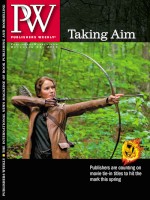The story of how Jan-Philipp Sendker’s first novel came to be published in the U.S. 10 years after its initial publication in Germany is a story a lot like the one fluttering at the core of The Art of Hearing Heartbeats (Other Press). And that story of love and determination—grand, touching, and unabashedly romantic—is, it turns out, a lot like Sendker himself.
If success is 1% inspiration and 99% perspiration, a sweaty insistence is all over Sendker’s debut about the enduring love of Tin Win, a Burmese boy, born blind and abandoned, and Mi Mi, the crippled girl who becomes his eyes.
For two years starting in 1999, Sendker and his wife, Anna, lived in a cabin near Monticello, N.Y., so that Sendker, a journalist for the German magazine Stern, could write a novel. He called it Das Herzenbören (The Heartbeat), finding inspiration in his young son’s astonishment at being able to hear his father’s heart through his chest. The book “is about total trust,” says Sendker, who frames an epic romance around a mysterious disappearance. Against amazing odds, Tin Win grows up to become a successful lawyer in New York and a family man, with a daughter, Julia, following in his footsteps. When the story opens, it’s been four years since Tin Win disappeared, seemingly of his own volition. When Julia finds a 40-year-old love letter written by her father to a woman named Mi Mi, she goes to Burma to find Mi Mi and discover what became of her father. But what she learns is a lesson in determination and the kind of love that “breathes meaning into life.”
When The Heartbeat was published in Germany in 2002, Sendker had high expectations. “Sixty thousand hardcover in the first two weeks,” he jokes. Instead, the hardcover sold 6,000 copies, and Sendker had to go back to Stern. But he returned to journalism determined to get his book published in the United States. “It was my dream,” he says.
The next 10 years tried even Sendker’s impressive resolve. It started with a visit to the foreign rights director of Bertelsmann in Germany. Sendker told her that he wanted his book to come out in America. “‘Yes, Mr. Sendker,’ she told me, ‘many authors would like that.’ ” Next Sendker searched the Web for editors in America who read German, and flew to New York to try to see them. With the exception of an editor at Norton, who met with him but passed, everyone said, “Leave the book at the front desk.” Sendker heard back from no one. He needed a translation, he decided, one he’d have to pay for himself. By now, three years had passed since the hardcover had come out in Germany.
A circuitous search for translators led him to Kevin Wiliarty, a graduate student who did the first 40 pages on spec. “He was so good,” Sendker says, “that I sometimes looked at the original and thought, ‘Do I really write that well?’ ” Nine months later, the translation was complete, but by then, Sendker knew he needed an agent. So he returned to New York once more. “The same thing happened,” he says. “ ‘Leave a copy at the desk.’ It was a humbling experience.”
But Agnes Krup, then working with the Karpfinger Agency in New York, took him on in 2007, and sold the book to six countries. Meanwhile, German sales had picked up. Buoyed by great word-of-mouth, the number of copies sold climbed to 150,000. “But still, no American publisher,” Sendker says. “Agnes told me to forget about it.” At the East Village cafe where we met for espresso, Sendker sits back. “I remember very well the evening when I told my wife, ‘Anna, this has been my dream, but there are some dreams that don’t come true.’ ” A week later, a mutual friend introduced Sendker to Judith Gurewich, the publisher of Other Press. His dream had come true.
As German paperback sales top 400,000 and foreign sales continue to climb, Sendker says, “I think it’s a noncynical book in very cynical times. It gives you some certainties, about love and trust, in very uncertain times. Everything I know about love and life I put in that book.”



 Volume 258
Issue 50
12/12/2011
Volume 258
Issue 50
12/12/2011





